|
|
Home | SBOI-Group| Pictures | Audio-Video | Wallpapers| Greeting-cards | Ashrams Info. Sai news
|
|
Burra Katha chekka bhajan
After the hectic month of February there was just a short lull, before the busy afternoon schedule was resumed. Kicking off the programs in the month of March was a Burra Katha, an active and vibrant rural art form endemic to the region of Rayalaseema, where Puttaparthi is situated.
The land Rayalaseema was ruled by a great king called Sri Krishna Devarayulu whose Vijayanagar kingdom included the current states of Andhra Pradesh and Karnataka. Krishnadevaraya was a wise and just king who transformed this region of rayulu (stones) into ratnaaluu (diamonds).
|
It was his
minister, Thimmarasu, who took the concept of Yakshagana, a
stylized drama form from the Kannada speaking region of Karnataka, with
elaborate costumes and music into a simpler art form adapted to the Telugu
speaking region wherein three men went around the nook and corner of the
kingdom trying to spread the word of the king, his plans and upcoming
projects. These three men had fixed roles - that of a bard (kathakudu),
a narrator (rajakeeyam) and a hasyam - a comic providing
relief through caustic humour using contemporary issues. This was a fusion
of information and entertainment at its very best that resonated well with
the target rural audience.
|
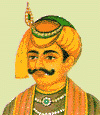 |
|
| Krishnadevaraya |
Traditional art forms (Janapadha Kala) that prevail over time are those which penetrate easily and deeply into the minds and the hearts of the people (Jana). These traditional art forms mirror the lifestyles of the people in the villages where the majority of India’s population lives. A number of such traditional art forms are extant in Andhra Pradesh; a few being: Burra Kathalu (an art form with a trio telling a story with songs, narration and humour); Hari Kathalu (a singer - haridasu - who narrates the story of the Lord through melodious songs and simultaneously taps his feet to the rhythm); Uggu Kathalu (a form of folk art where mythological stories are narrated to the audience); Jamukula Kathalu (consists of a trio narrating a story through songs); Jangama Kathalu (a traditional folk art of telling a story, where the group moves from place to place); Thappidi Gulu (a dance accompanied with songs; the singers wear a drum called thappidi around the neck); Veedhi Bhogavathamulu (a small group moving from street to street narrating stories); Veedhi Natakamulu (street plays on social issues interspersed with music); Chekka Bhajanalu (singing songs using thalam or cymbals), Thollu Bhoomalakatlu (a puppet show). These art forms thus run the entire gamut from puppets on a string to different dance and song art forms as well as the hoary art of story telling in different milieu.
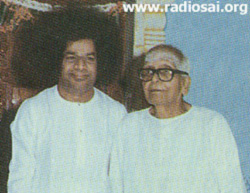 |
Those of our readers who have read Swami’s wonderful biography Sathyam, Sivam, Sundaram by Sri Kasturi would perhaps recollect that right from an early age Swami took a keen interest in these traditional art forms. Swami wrote, enacted and directed many plays during His childhood days. He also started a pandhari bhajan group that used to go from village to village singing the glories of the Lord. And of course, the famous story where He danced and surpassed the skill of the most famous professional dancer of the day (Rishyendramani) and earned the accolade of one and all is still evergreen in our memory. |
|
|
Prof. Kasturi with Swami
|
|
While the kings of yesteryears patronized the arts, the plight of the present day artists in the villages is deplorable. Even though the spark of enthusiasm and the love of their art glow in their eyes, their empty stomachs force them to look for alternate employment as their art alone does not prove sufficient. And for all in dire situations, God is the only refuge. Swami in His own unobtrusive and silent way has been trying to revive these ancient art forms. These art forms have always been performed in Swami's divine presence over the years; usually the artists were professionals drawn by Swami's love to perform in His divine presence from places in Andhra Pradesh like Guntur, Hyderabad, and Warangal and so on. In later years, Swami has been encouraging the students to learn these arts and perform them in His divine Presence. |
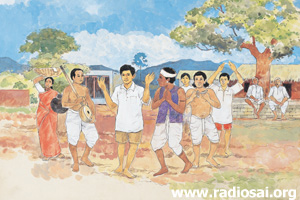 |
|
|
Swami and the Pandhari Bhajan
group
|
In 1988 a troupe from Guntur performed a style of bhajan singing and dancing called chekka bhajan. Swami was so impressed, that this started a close and intricate relationship between the chekka bhajan group and Swami’s students over the next few years.
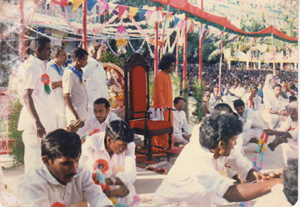 |
After the students of all
campuses were trained, they presented a number of professional quality
performances before Swami and the devotees on different occasions. For a
full account of this absorbing love tale please read the story entitled “Chekka
bhajan and Sai Students” in the box below.
A decade later, perhaps in late 1997 or early 1998, quite unexpectedly and with little notice, Swami called a few traditional artists from the villages around Puttaparthi and had them perform a street play before the students in the Institute Auditorium. This was very well received and for most of the ‘next generation students’, this was perhaps their first exposure to these traditional rural art forms. |
|
|
Chekka Bhajan troupe on Nov
21, 1988
|
The boys ever quick to do what pleases the Lord, quickly started taking an interest in these art forms. Swami engaged experts in the various fields to come and teach the students of the School and the Institute and they have (in addition to chekka bhajan) learnt the nuances of Burra Katha, Hari Katha, Pancha Vadyam (an art form from Kerala), and Nadaswaram that is prevalent throughout South India. Very soon, on Nov 22nd, 1999, as part of the convocation drama, the boys Sujith, S. Prashant and Karthik performed the first burra katha by the students called Pandavulu.
Sri Krishna Bhaskar, a burra katha artist, lyric writer and music composer is a long time devotee of Swami and has performed more than 20 burra kathas in the divine presence during the years 1961-1982. He has been training the boys since 1999, and they have creditably performed quite a number of Burra Kathas that he has written, over these past 7 years. They have not only performed during the convocation dramas and in Sai Kulwant hall but have regaled the Lord with a burra katha whenever He visited their hostel. On March 9th, 2006, they performed yet one more katha to please the Lord!
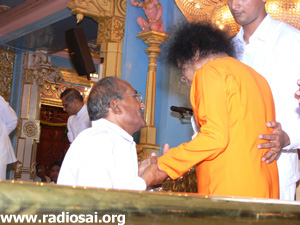 |
 |
|
|
Swami blessing Sri Krishna
Bhaskar on March 9th, 2006
|
Lambadi Dancers in Sai Kulwant
Hall
|
Quite recently, on Feb 10, 2005, when Swami conducted the spiritual marriage ceremony for octogenarian couples, aged 70 years and over, called as Bheema Ratha Shanti, the featured item was not a big name artist to sing for all. No, the entertainment was provided by the Lambadi (gypsy) dancers, hailing from Warangal, who looked very colourful in their red outfits and really won the hearts of one and all with their elegant dance steps. Thus slowly but surely, Swami is exposing all of us to the vibrant art that is alive in the villages and the small towns of the country and generating in us a deep and abiding love for the culture that is Bharat! The mills of God grind slowly but they grind exceedingly small.
|
CHEKKA BHAJAN AND SAI STUDENTS It was during the Silver Jubilee Celebrations of the Sri Sathya Sai Seva Organisations in 1988 that a folk festival was organised in the Divine presence by the Andhra Pradesh State Organisation. From every district of Andhra Pradesh, a native folk dance group was selected and a rally was performed before Swami in Prashanti Nilayam. The rally lasted for more than 3 hours with every folk dance group performing for just 5 minutes in front of Swami. Folk dances like Thappeta gullu, Garagalu, Dhimsa, Guravayyalu, Dappu Vadyam, Puli Vesham, Veera Natyam, Chekka Bhajan, Kolatam and many such came up in procession and performed before Swami. Swami was immensely pleased and His joy was boundless.
‘Chekka' means a wooden piece; but, in the context of the folk dance, it is a pair of wooden pieces, specially prepared to be used as the main percussion instrument to the rhythm of which the dancers dance. In Chekka Bhajana both the Chekkas are held in the right hand and the other hand is used for occasional, generalised gestures. The chekkas not only provide the basic rhythm, but with the jingling bells tied at the ends and the metal pieces fitted into the chekkas give a more pleasing variety of sounds. By opening and closing the palm, the chekkas can be struck at each other, which produces metallic and jingling sounds at the same time. Chekka Bhajana, more than any other folk art, has remained a temple art form for many centuries. It is popular especially in the Sri Rama temples, which abound in Andhra. No village in Andhra, however small, exists without a Rama temple and wherever there is a Rama temple; Chekka Bhajana is bound to be performed. It has been a happy and absorbing folk dance, learnt during the lean months of summer when villagers are relatively free from their agricultural work and presented to the villagers in the following festivals. A Chekka Bhajana group consists of 16 to 20 artists sometimes even more up to 40, but is always an even number. The costume of the artists is simple, but colourful: a dhoti tied in the fashion of a cyclist, a colourful shirt on it, a garland around the neck, garlands tied to the hands, and a coloured kerchief around the neck and ankle-bells. They will also tie a wide, coloured ribbon around their forehead, tied in an artistic way on the right side. Each dancer prepares his 'chekkas' with utmost adoration. On the outer side of each piece, the images of Rama, Sita and Laxmana are engraved. Otherwise, they may have beautiful creepers painted. The songs are usually taken from the popular texts on Rama - written by Bhadrachala Ramadas, Tyagaraja, Tumu Narasimha Das and other saint-composers. Some of the local writers wrote songs on other gods and goddesses. There are also episodes from Krishna 's life, from Harischandra, etc., but the songs and narratives on Sri Rama are more in number and more popular.
In 30 days time the students learnt the folk dance form of Chekka Bhajan and they were asked to perform in public and before Swami during the Sports Day Celebrations. The students performed in perfection, just like a professional group, to the delight of all the spectators and Swami on 11 th of January, 1989. Swami was so pleased that he summoned every student to the Shanti Vedika and blessed them. He summoned the Master Sri Koti Reddy and felicitated him in presence of all the dignitaries.
Impressed by the performance of the Bala Vikas children in Chekka Bhajan Swami again summoned the bhajan master to teach Chekka Bhajan to the new batch of students of the Institute, the Higher Secondary School and the Primary School. In less than a month’s time a “near professional” 3 teams of Chekka Bhajan were trained in the campus. Every team performed before Swami during the Birthday celebrations in 1996 and later in the same year the Masters were summoned to train the Girls of the Primary School. The Junior Master Sri Brahmananda Reddy and Assistant Master Sri Prasada Reddy trained the girls of Primary School and on the Ladies Day of 1998 - on the 19th of November, the girls of Primary School performed Chekka Bhajan with a professional perfection in the Divine Presence and they were blessed by Bhagavan. Heart2Heart would like to thank Sri Koteswar Rao of Guntur for providing the material and photos for this box story on chekkabhajan. |
MARCH 9TH: A BURRA KATHA BY THE INSTITUTE STUDENTS
The three boys who had prepared for the different roles in the Burra Katha, had a card ready to seek the divine blessings to put up the programme the next day. The Lord perhaps reflecting His enthusiasm for this genre said, “Put it now itself”.
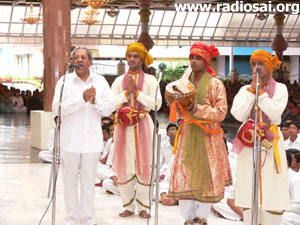 |
Readers can perhaps best imagine the hectic activity that ensued. A quick run had to be made to the Hostel to get the costumes and the musical instruments. The costumes were quickly donned, the instruments fine-tuned and make-up applied almost in “real-time” so that in a matter of about 20 minutes the boys were ready to offer their presentation! In order to alleviate the confusion among the devotees who were all wondering about this frenetic activity, Swami asked Prof Anil Kumar to introduce the programme that was going to be presented that afternoon. The boys started their programme with a salutation to Lord Ganesha – Jaya Jaya Gananathaam followed by a song that offered salutations to our beloved Mother Sai – Maata Neekide Vandanam. A few years ago when the boys first performed a burra katha in front of Swami He had asked that after the first invocation song the boys should be garlanded in keeping with the tradition. Thus the 3 burra katha artists were next garlanded to the merriment of the crowd. |
|
|
Prof Anil Kumar making the
introduction
|
|
The story proper began with the third song Katha Chebuta Vinarayyah … “Let me tell you the nectarine story of Shirdi Sai, O noble men who have assembled in Sai Kulwant Hall”. The next song announces that they were going to hear the unique story of the avatar hood of Shirdi Sai as revealed by Swami Himself - Shirdi Sai janamu telipunu Sathya Sai manaku. (In answer to the intense prayers of a couple called Gangabhavadya and Devagiriamma in the remote village of Pathri in the former Nizam’s dominions, a son was born on September 28 th, 1835 – who would later be known as Shirdi Sai Baba). The fifth song, Kadilenu Shivudu…., tells about Lord Shiva coming down to earth to test Devagiriamma in the disguise of a decrepit old man, at a time when her husband was away looking after his boats on a rainy night. |
 |
|
|
Sai Prabhakar is the Kathakudu,
the bard
|
This “old man” requested first shelter, then food and finally asked the married woman Devagiriamma to massage his legs as he was tired. Not knowing what to do, Devagiriamma went around the village looking for someone who would do the task. Despondent at being unable to find anyone to help her she prayed to Lord Shiva to help her.
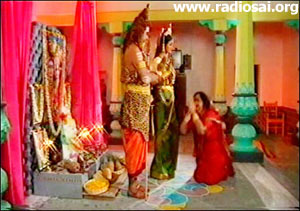 |
Parvathi (Lord Shiva’s consort) then knocked on the door and offered to help Devagiriamma. Devagiriamma, having no clue about the divine nature of the lady, was elated that Goddess Parvati had sent the woman to help in response to her prayers. She sent the newcomer to the veranda for serving the old man and closed the front door. However, the “old man” and the “newcomer” were none other than Parameshwara and Parvathi, the divine couple! They wanted to bless Devagiriamma and knocked on the door and revealed themselves in their divine form to her. Unable to contain her joy, Devagiriamma fell at their feet. The divine couple blessed her and said that she would have a son to maintain the lineage and a daughter for kanyadaana (to be offered in marriage). Lord Easwara said,” I am immensely pleased with you and shall Myself take birth as your third child”. |
|
|
The Divine Couple blessing
Devagiriamma
|
When the husband returned in the morning, the eager wife related to him all that had happened the previous night. But Gangabhavadhya dismissed the entire episode as incredible and fanciful.
The sixth song Hara Hara Shankara …. tells about Gangabhavadhya praying to Lord Shiva to bless him with the Divine Darshan. The seventh song, “Bhaavateeta kaalateeta” tells about Devagiriamma praying to Lord Shiva to grant her a child.
|
The story
continues. After a year had passed, Devagiriamma became enceinte and a son
was born to her, followed a year later by a daughter. Gangabhavadhya was
now convinced that the birth of the two children was the result of the
blessing conferred by Parvathi and Parameshwara. He told his wife, “You
had the good fortune to be blessed by the divine couple. I did not have
the luck”. When Devagiriamma conceived again Gangabhavadhya began to feel
an urge to give up hearth and home and go in search of the divine couple.
He announced to his wife that he was leaving for the forest to do penance.
The devoted wife Devagiriamma decided to follow him, though she was in the
ninth month of pregnancy. After proceeding some distance, she developed
labour pains and delivered a boy in the forest. Wrapping the baby in a
piece of cloth she left the child in the forest and went in search of her
husband. It was because of this circumstance that no-one knew who the
parents of the child were.
|
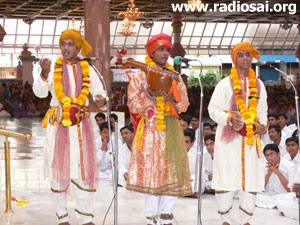 |
|
|
The Burra Katha in progress
|
The eighth song Paramahivamu tallidandrulu evaru cheppagalaru … wistfully asks who can decide the mother and father of the cosmic dancer?
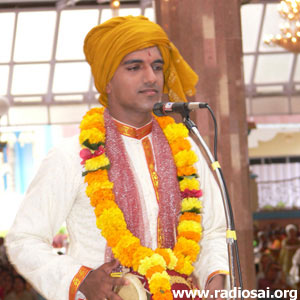 |
The fakir who found the child in the forest brought him home and brought him up as his own as he was childless. The boy stayed in the fakir’s house for four years (1835 - 1839). However, the fakir then passed away. The fakir’s wife who lavished great love on the little child was grief-stricken. To add to her worries the boy was behaving in a “strange” way. In those days, Hindu-Muslim differences were prevalent in the region and considerable bitterness prevailed between the two communities. The boy used to visit a Hindu temple and sing the praise of Allah, “Allah malik hai” – Allah is the Supreme Lord. Similarly, He would visit the mosque and declare, "Rama is God; Shiva is Allah”. Thus the aggrieved members of both communities went to the fakir’s wife and complained about the boy’s behaviour. Unable to deal with the situation, the fakir’s widow handed the boy, for upbringing, to a pious scholar called Venkusa who was living near her house. The boy stayed in Venkusa’s Ashram for 12 years from 1839 to 1851. One night in 1851, the boy left the Ashram and reached Shirdi, which was a small village at that time. He stayed there barely two months and was then wandering from place to place. After many years, he reached a place called Dhoopkheda. |
|
|
Sai Raghu Ram narrating the
story...
|
The ninth song Baba Vacchadu Shirdi Baba Vachcadu …. tells about how the residents of Dhoopkheda village used to invite Him to their homes.
|
When He was residing in Dhoopkheda, the marriage of Chandu Patel’s brother’s son was celebrated. Baba joined the marriage party and reached Shirdi again. From that day till 1918, He did not move out of Shirdi and remained there for 60 years. Baba’s complete life span was for 83 years from 1835 to 1918. In Shirdi, Baba was invited to each and every home. Similarly in Puttaparthi, devotees and students await the return of Bhagavan Sri Sathya Sai Baba from Brindavan. This sentiment was memorialized in the next song “Dosita Hulabi Poovulato Nee Vaakita Nilabadi Unnamaya” meaning - 'With a handful of beautiful rose flowers, standing near Your door-step; we await Your return from Brindavan to Parthi'. |
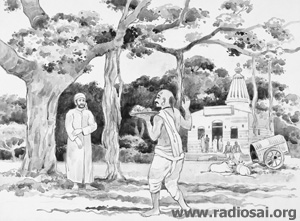 |
|
|
Baba arriving in Shirdi
|
The eleventh song Shiva Tarudu Shirdi Sai Gaa glorifies Lord Shiva for coming down to earth as Shirdi Sai and restoring peace in the world.
Baba in the year 1918 told a devotee called Lakshmibai that He would take His next avatar after 8 years in a hamlet known as Puttaparthi, in Andhra Pradesh. And that avatar is none other than our beloved Sri Sathya Sai Baba.
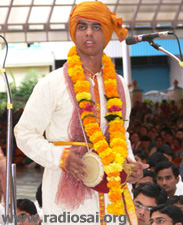 |
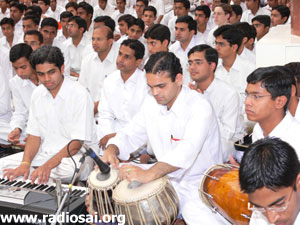 |
|
|
Arvind Sai is the hasyam
- providing the comic relief |
Providing the music for the
Burra Katha
|
The twelfth song (Sakshat Daivam saiyera...) tells that only the loving and living God i.e. Swami is real and eternal and everything else in this mundane world is transient. The thirteenth song (Mugimpulenidi Baba Charitramu) further adds that Baba’s story is infinite.
The last song was a prayer for every one of us to open our eyes and realize His true value. Ayya baboyi Ikkadunnavah; nee Kosam Etiki Etiki Tirugutunnam Sai deva – “Oh my dear Swami! Not aware of You being here, we people go everywhere in this world in search of external material objects. Let us all surrender ourselves at Your Lotus Feet”.
|
B. Sai Prabhakar, a second year B.Sc student, was the bard, S Aravind of II B.A. played the role of the comic and Sai Raghu Ram another second year B.Sc. student did the narration. The melodious voices of these boys were well supported with soothing, mellifluous accompaniments with Sanket Modi on the key-board, Niranjan on the tabla and Raghavan on the dholak. It was an enjoyable time for all, even for those of us who do not know Telugu, but were able to appreciate the sentiments expressed in the song. Swami also expressed His pleasure by posing for a group photograph with all of the boys (who brought this excellent programme to Sai Kulwant Hall) and their teacher. |
|
|
|
A Group Photograph with all
the Artistes
|
MARCH 12TH: SPEECHES BY LONGTIME DEVOTEES
On Sunday, March 12th, after Swami entered Sai Kulwant hall, He seated Himself on the dais in the verandah and listened to the Vedam chanting for a few minutes. Soon, unexpectedly He asked that mikes be set up and chose 2 longtime elderly devotees, who are associated with Him over many decades to address the gathering.
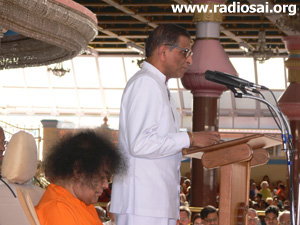 |
After a brief introduction by the Vice-Chancellor, Sri A. Gokak, Dr S.V. Chittibabu rose to speak at the divine command. Dr Chittibabu retired as the Director of School and Collegiate Education in Tamilnadu. In a distinguished career, he also served as the Vice-chancellor for Madurai, Andhra and Annamalai Universities. He also has been a member of a number of committees connected with the activities of education and education reform. He has been associated with the Sri Sathya Sai Institute of Higher Learning since its inception and has a very special relationship with the Institute. He has been a member of the Governing body since 1986 and has been an ardent devotee of Baba for over 40 years. |
|
|
The Vice-Chancellor introduces
the speakers
|
Speaking in a soft voice, Dr. Chittibabu first narrated how Swami came into his life in 1962. He said that he used to suffer from severe headaches which frightened him. He was desperate about how he was going to overcome this ailment. It was his sister-in-law who suggested to him to seek refuge in the love of the Lord of Puttaparthi and that He would take care of everything. With that firm faith, he came to Parthi all the way from Chennai and was given an interview. In the interview, Swami immediately asked him – “Are you having problems in the head?” He was just stunned. Swami then materialized the sacred vibhuti prasad and applied a little on his forehead. Even before he left Parthi to return to Madras (Chennai), his headaches were gone! Sri Chittibabu said that we are most fortunate to have in our midst a living and loving God, who has chosen to incarnate and rescue humanity from the prevalent chaotic situation.
|
Quoting Swami, Dr. Chittibabu exhorted the audience to be courageous and be bold and have full faith in divinity. He said that we have innate wisdom inherent in all of us but that wisdom must flower. He also said that we should not be sleeping but be a dynamo of action. We must nurture noble thoughts and mould those thoughts along the right lines. Right thoughts must then be followed by right action. Dr Chittibabu also remarked about how Swami loves humanity by mentioning His myriad selfless projects to benefit humanity. Quoting Swami, he then asked everyone not to be selfish as the world is not for you alone. |
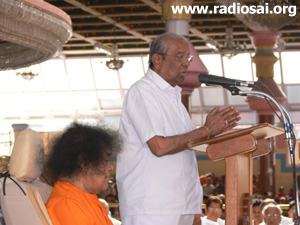 |
|
|
Dr. Chittibabu addressing the
crowd
|
In closing, Dr Chittibabu said that we can return His love by demonstrating that we are all loving brothers and sisters. He said that the world must become a better, brighter and happier place. He ended with a prayer to the Lord to give us the strength to bear our sorrows and keep our mind above the petty trifles of day to day; and to give us the strength to make our love fruitful in service to humanity. He finally prayed that everybody can live in peace, harmony and shanti in this great land of ours.
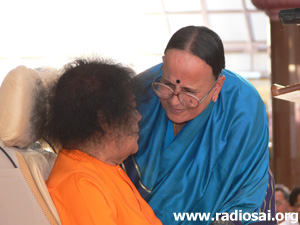 |
Speaking next was Prof. (Mrs.)
Jayalakshmi Gopinath, Warden, Anantapur Campus, of the Sri Sathya Sai
Institute of Higher Learning. Speaking in an a very unassuming manner,
Jayamaa (as she is popularly known) electrified the audience with her
touching stories of the Lord’s love and glory drawn from her 57 years of
association with Him. Though it makes the excerpt long, we bring the
highlights of her speech to you so you can fully appreciate the
mesmerizing effect of the spell that she wove on the audience that day.
She said,
|
|
|
Dr. Jayalakshmi Gopinath gets
Swami's blessings
before speaking |
After enthralling us with these wonderful stories of Swami’s grandfather and His parents, Jayamaa then talked about His first public discourse in 1951.
|
What a glorious evening listening to such enchanting stories of the Lord!
MARCH 13th: MEERA BHAJANS BY THE STUDENTS OF THE MUSIC COLLEGE
Ever since the Sai Mirpuri College of Music has been established, it has become a tradition that towards the end of the academic year, the students put up a concert for Swami, as it provides them a forum to show-case what they have learned during the academic year.
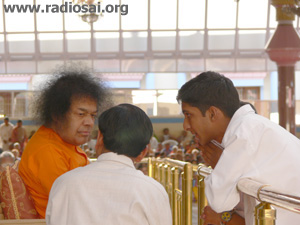 |
He asked them instead to prepare and sing “Meera bhajans”. And the boys ever keen to comply prepared a list of His favourite Meera bhajans and practised and practised till they felt they were ready to sing in the Divine Presence. But one of the Lord’s favourite tricks is to play hard to get. No sooner were they ready then He started ignoring them. So one day of waiting became two and so on and it soon became a full week of waiting and intense prayer for the Music College boys. |
|
|
Swami talking to the boys
before the programme
|
But our Lord knows when the time is right. And on Monday, March 13th, Swami comes and sits on the dais and asks the warden – in all innocence and pretending full ignorance – “Is any program ready?” The warden being fully attuned to the ways of the Lord quickly replied, “Yes Swami. The Music College boys have a program ready for You”.
And so the stage was set! Swami gave His blessings and the Music College boys found themselves at centre-stage in Sai Kulwant Hall with their instruments.
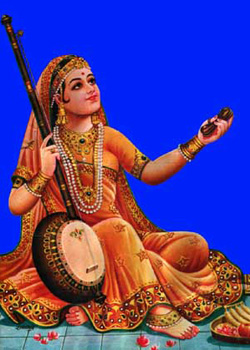 |
But who is Meera and why is Meera bhajan such a perennial favourite of the Lord? Meera or Meera Bayi as she is known was born in 1547 A.D. and left this world in 1614 A.D. She was an intense devotee of Lord Krishna. Her songs are composed in the agony and ecstasy of devotion. Hence her songs of bhakti are one of India’s richest heritage and a legacy of all seekers on the royal road to God through the path of devotion. Meera Bayi was born as a princess and so she was married to the prince of one of the major Rajput kingdoms of those times. Soon after marriage she faced widowhood and her intense devotion towards Lord Krishna, which she had since her infancy, grew even more now and soon became so dense that Meera remained blissful all the time totally immersed in her love for her Lord. Intoxicated with intense devotion for her beloved, unable to bear the separation from Him, she poured out her heart in her songs. Lost in bliss she used to dance in ecstasy. Her family could neither understand nor condone her “strange” behaviour and would hence torture her in many ways. At last she left the confines of the palace and went on a pilgrimage. While having darshan of Ranachodji in Dwarka, she merged in Him her Beloved! |
|
|
Meera in ecstasy
|
Why is her bhajans so appealing to the Lord? Because each word of each song drips with the bhava (feeling) of intense devotion. After all the Lord does not look at the devotee, He only looks at his or her devotion. And Meera’s songs are so overpowering, so intoxicating, coming straight as they do from the deepest and innermost recesses of her heart, that it is no wonder that she has also fully won her Lord’s heart for eternity!
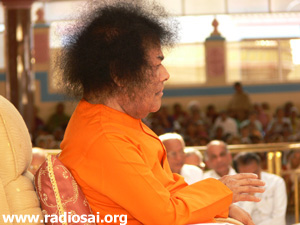 |
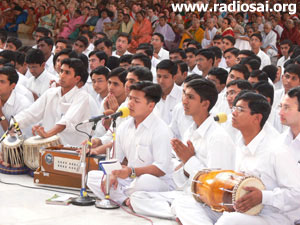 |
|
|
Swami keeping tune to the
bhajans
|
The boys sing for Swami
|
The concert began with a prayer to Lord Ganapathi “Jai Ganapati Vandan Ganayaka” wherein the singer describes His various forms. Following this was the Meera bhajan “ Maine lino Govind mol”, where Meera declares that she had purchased Lord Krishna by paying in love. The next Meera bhajan “Paga ghungru bandh meera nache re”, she displays her state of bliss and joy which she felt after experiencing oneness with Lord Krishna. In the fourth song that was presented – “Payo ji maine rama ratan dhan payo” – she described Lord Krishna as a unique treasure which she had attained. Again in the fifth composition (Aisi laagi lagan Meera ho gayi magan), Meera Bayi described her bliss, full bliss. The sixth composition (Jaga mein sundar hein do naam) tells about the beauty of the Lord’s name. In the seventh song – “Mere to Giridhar Gopal” – she expresses that Lord Krishna is her only property. The last Meera bhajan that they sang that day was “Vighana harana Gouri ke nandan”, a prayer of 'Oh Lord! Soon take me out of this cycle of birth and death.'
The last two songs that they presented that day were a taraana type of singing – Raag Todi and Raag Bageshri. Tarana (called Thillana in Carnatic music) is sung at a fast tempo and make use of words like Ta Na Na, De Re Na etc. These words have no meaning per se, but Swara Gamaka (modulation of the voice) is the main essence of this type of singing.
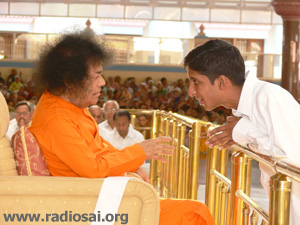 |
After the concert, Swami requested the boys to sing the Meera bhajan “Pyare darshan dijo aaj”, but the young boys had not practised this song and were hesitant to sing it before the Lord. The following day during the afternoon darshan, Swami again called the boys up to Him and expressed that he liked the bhajans “Paga ghungru bandh meera nache re” and “Mere to Giridhar Gopal”. The eager boys immediately said that they had practised the bhajan that He requested yesterday and were now ready to sing it. Swami said “Yes, yes” and also expressed that they need to practice more. But that was not all. From the following day for the next few days, Swami took them under His care and taught them personally how to sing Meera bhajans. A dream come true for any music student – to learn how to sing from the Lord Himself! |
|
|
"Can you sing this bhajan"?
|
How many lifetimes of good deeds must have resulted in the fruit of this golden opportunity for these blessed souls? And we also wondered – is Swami preparing them so they could play again on the bigger stage of a festival day in Sai Kulwant Hall? Only time will tell.
The vocalists were Koustubh Pare, Rahul Sharma, Sanket Modi and Abhinav Sitoke. Accompanying music was provided by Abhishek Narayan Acharya on the tabla, Sanket Modi on the harmonium and V.S. Raghavan and Niranjan Kanedia on the percussion instrument Naal.
MARCH 15TH: HOLI CELEBRATIONS BY THE DEVOTEES FROM BIHAR AND JHARKHAND STATES
States around the country pick one of the many festivals that dot the Indian calendar that they would like to celebrate in the Divine Presence. Devotees from Maharashtra, for example, like to celebrate Ashadha Ekadashi; Gujaratis their New Year Day that coincides with Diwali; devotees from Kerala come to celebrate Onam and Vishu; Tamilnadu’s devotees come to celebrate Pongal and the Tamil New Year; but the celebration of the festival of Holi in Sai Kulwant Hall is specially associated with the devotees from the states of Bihar and Jharkhand.
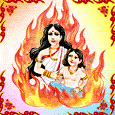 |
Holi is a
festival of fun and gaiety but also has a serious underpinning. Legend has
it that the name came from Holika the sister of Hiranyakasipu, who had a
boon that fire could not consume her. She took Prahlada into the fire with
her to kill him at the instigation of Hiranyakasipu who wanted to kill his
own son, as Prahlada worshipped the Lord rather than Hiranyakasipu
himself. Needless to say the Lord always runs to protect his devotees and
it was Holika herself who perished in spite of her boon and Prahlada came
out unscathed from the fire due to the Lord’s grace. Holi is thus a
celebration of the triumph of good over evil and even today bonfires are
lit and unwanted things are consigned to it.
|
|
|
Holika sitting with Prahlad in
the fire
|
But the quintessential image of Holi is as a festival of colour and uninhibited fun. People put on old clothes and the old and the young are rejuvenated when they go out into the streets and “play Holi” i.e. sprinkle or apply colours on each other. In recent times however, due to the pernicious influence of Kali Yuga the good clean fun has become an opportunity for the baser elements of society to indulge in rather unsavoury and puerile behaviour especially towards the fairer sex that brings the festival a lot of disrepute.
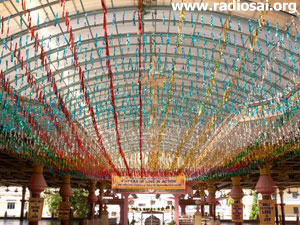 |
 |
|
|
Sai Kulwant Hall was
tastefully decorated
|
Banners were hung all over the
hall
|
But the festival of Holi was celebrated in a very holy manner on March 15th in the divine presence by a good crowd of about 300 devotees from the North Indian states of Bihar and Jharkhand, who had braved the rigours of travel (the border of Bihar is at least 2300 miles from Puttaparthi) at the onset of summer to be present in Sai Kulwant Hall on this momentous day.
Sai Kulwant Hall was gloriously decorated that day with streamers that stretched all the way across the roof. The façade of Sai Kulwant Hall was bedecked with floral garlands and on the pillars were hung small signs wishing all devotees on this holy Holi day.
The Morning Program
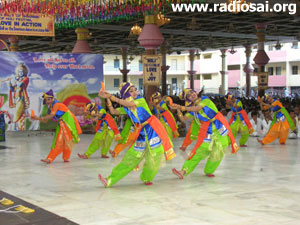 |
The celebration of pavitra Holi or Holy Holi begins in the morning after Bhagavan’s arrival into Sai Kulwant Hall with a dance expressing gratitude to Him through the Navagraha Stuti (a song of praise to the personification of the nine aspects of divinity). Everyone’s hearts are eager for His darshan, as they feel they have no existence without God. And having obtained His darshan, they express their feelings in the accompanying song – “Wherever our minds revel, we see your form; wherever our heads bow, we see thy feet installed”. This was followed by a salutation song to our Lord – Hey Saeshwar, Hey Jagdhguru, Hey aadi-anadi Avinashi… which means “Hey Saieshawara, our Lord, the whole of Bihar offer their salutations during this pavitra festival of Holi. You have always been showering Your Grace on us in abundance. Please give us the power to discriminate. May we all be of some service at thy lotus Feet. Do forgive our shortcomings”. |
|
|
The opening Navagraha Stuti
dance
|
This was followed by a Qawali song, a song and dance mode, influenced by the Islamic culture that is popular in the Northern areas of the country that saw long periods under the foreign Mughal occupation. The Qawali song was “Tere darbar ka Sai ajab taseer dekha hai…. We have seen something wonderful in your darbar; everyone makes a fortune here. O! Lord of Puttaparthi, You are the saviour of all. You love and respect the poor and reside in their hearts. You lead us to truth and kindle the light of wisdom. Oh Lord! Carry us across the Ocean of life.
The qawali dance girls were authentically made up in period costumes and gave a very good rendition to the appreciation of the entire crowd.
|
This qawali program was followed by a song entitled Param Brahm Sathya Sainath ki, Abdhut Leela nyari… This song draws our attention to the fact that Sri Sathya Sai, the Para Brahma, has incarnated in this Kali Yuga for the sake of humanity. He brings about transformation in the lives of people and shows them the path of righteous living. This was followed by yet another song this time sung in Bhojpuri, the dialect spoken in most parts of Bihar. Labelled as a Lok Geet or a song of the people it runs thus, Aaara! Holi rang rangol, mausam basant bahar va….. “The Glory of Parthi is unimaginable. Men and women from all over the world come to have Sai’s darshan. The festival of Holi is being celebrated in Baba’s darbar during the spring season. He looks after all those who rely on Him fully. Come let us sing together – Sa ra ra….” |
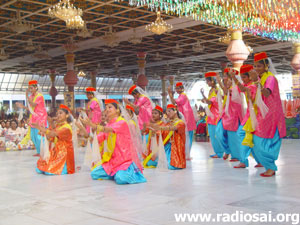 |
|
|
The Qawali Dance
|
Next was a song and dance routine called as the Holi geet or the song of Holi. Happy girls came dancing onto the centre of Sai Kulwant Hall singing the quintessential Holi song and the whole crowd got involved and kept the beat along with the singers. Rang gayee rang gayee hai Parthi ki dagri… Parthi is looking very colourful with everybody dancing in joy. Sri Krishna is playing with the cowherd boys and Radha too is with Her friends. Oh Bhakthas! Fill your pockets with colours; we shall play holi with Sri Krishna.
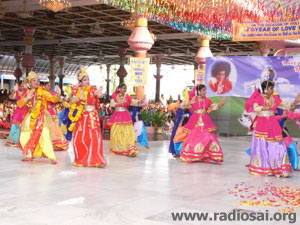 |
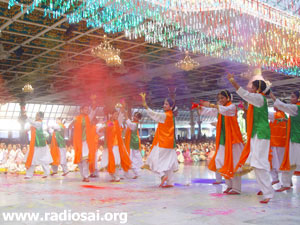 |
|
|
Radha and Krishna dancing with
the cowherd boys and girls
|
Holi is a festival of colours
|
Two more songs brought the morning programme to a close. The first one was a song entitled Gaalan gal galeen gavatan gopin gwal gulal lagave… a song trying to picture holi being celebrated in Parthi. The cowherd boys apply colours on the Gopikas. Radha dances with her friends. Kunj Bihari (Sri Krishna) plays His pranks and showers coloured water from the Jamuna. The sky showers Amrit (or nectar). Holi has brought festivity in Parthi. The beauty of Parthi is indescribable with the leelas of Sai Murari.
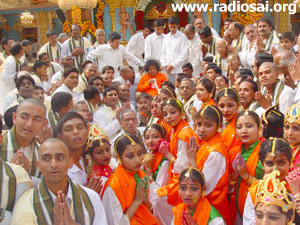 |
The finale song was Tera ham par hai lakhaon upkar…. Bless us O Lord! You have helped us innumerable times. The whole world is dancing at the onset of Holi. Puttaparthi’s divine beauty is out of this world, and it purifies the hearts of all. The bhagya vidhata of the world reside here. Even if the whole world turns away from me let me not leave Your door-step. May I always have Your name on my lips. Liberate me from the shackles of fear and take me under Your protection. Oh Sai! You are the same Rama and Krishna in the Kaliyuga. No-one has been able to comprehend Your glory; how can we mortals recognize You. Teach us the lessons of Love and shanti and show us the path of truth. Hey antaryamin, please accept our prayer. |
|
|
The group photograph
|
Swami was so happy that He patiently posed group by group with all for the all-important photograph, talked with everyone, consoling some, giving a word of advice here, blessing someone there and even making vibhuti for some-one who requested it.
The Evening Programme
In the evening it was the turn of the Bala Vikas boys. After the excellent morning programme by the girls, we were wondering how they could top it. And they did succeed! They elected to stage a drama of the life story of a great devotee of the Lord – Vidyapati - born in Mithilanchal in Bihar state. Mithila has been the centre of Sanskrit Vedicdharma from time immemorial. King Janak and Mother Sita were from Mithila.
Vidyapati hailed from a Brahmin family and had tremendous inner confidence on
his poetic and intellectual abilities. Vidyapati served Raja Shiv Singh as a
darbar (court) poet, whose compositions equally voiced the inner-most
thoughts of the king and the aspirations of the poorest of the poor. He penned
the highest devotion in his poems. Vidyapati’s love for Radha and Lord Krishna
depicts the pleasure and pain; as also the union and parting of any ordinary
person. His poems gained immense popularity during the time of Lord Chaitanya
Mahaprabhu.
Vidyapati is a great devotee of Lord Shiva. Lord Shiva appears in the life of
the poet Vidyapati to serve his param bhaktha. This real life story of
Vidyapati and his tenure with Lord Shiva as his domestic help was depicted in
the play. The story ended with the Divine message that the Lord can go to any
extent for the sake of His true devotees – even alter His own laws of nature to
answer the prayers originating from the hearts of a Param Bhaktha (a
top-most devotee).
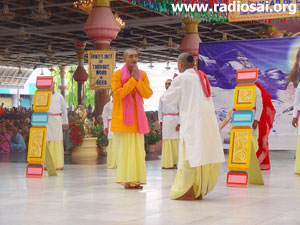 |
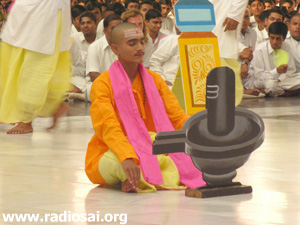 |
|
|
Vidyapati with his servant
Ugna
|
Vidyapati was a great devotee
of Lord Siva
|
The play was depicted in nine scenes. Scenes 1 and 2 laid the ground work with the participants first offering their pranams and then showing the appearance of Vidyapati appearing in the land of Mithila. They also depicted how Vidyapati was a great devotee of Lord Shiva even from his childhood.
Scene 3 develops the theme of his devotion further. They show how devotees in the Shiva temple are amazed at Vidyapati’s bhakti. They are inquisitive to know the secret of his deep devotion. Vidyapati explains to them that ‘sincere intense prayer’ is the best way.
The next scene portrays Vidyapati as a householder who did not leave home (and become a sannyasi) so that he could develop his spirituality. This offers hope that we too can aspire to develop devotion like him. Lord Shiva moved by Vidyapati’s devotion decided to serve him in his house as a domestic help - Ugna.
In scene 5 we see Vidyapati being summoned by Raja Shiv Singh. Vidyapati sets on the journey with his sevak (servant) Ugna.
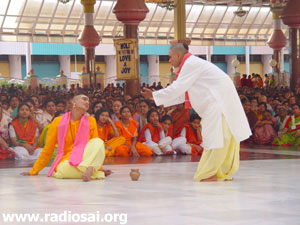 |
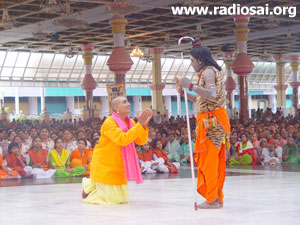 |
|
|
Vidyapati asks Ugna to fetch
him water
|
Vidyapati recognises Ugna to
be Lord Siva
|
In an emotional 6th scene they show how Vidyapati discovers that Ugna is in reality Lord Shiva Himself. In the middle of the journey Vidyapati feels very thirsty, and asks Ugna to fetch him some water. Ugna is unable to find any water, but takes out water from His matted hair (legend has it that the river Ganges resides in Lord Shiva’s hair). Vidyapati then immediately recognizes Ugna as being the Lord Himself. Ugna takes a promise from Vidyapati that he will not reveal His identity to anyone, else the Lord will disappear in that very moment. They then return home.
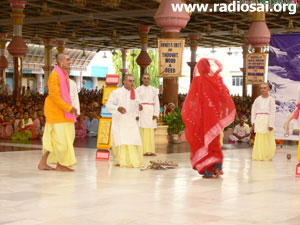 |
In Scene 7, they enact how Vidyapati’s wife is taken aback at their early return. She is a shrew and takes a dislike to Ugna and accuses him of loitering and wasting time instead of doing work and tries to keep him engaged in doing household work. Vidyapati, on the other hand, always tries to keep Ugna beside him. Scene 8 depicted how one day, Vidyapati’s wife gets upset when Ugna does not return from the woods (where he had gone to collect fire-wood) for a long time. In a fit of rage, she tries to hit Ugna. Vidyapati runs to his Lord’s rescue and the Lord promptly disappears. |
|
|
Vidyapati's wife ill-treats
Ugna
|
|
After this episode, in the final scene, Vidyapati prepares himself for Ganga Sevan (leaving his body while immersed in the Ganges). He gives parting advice to his children and hires labourers to carry him in a palanquin to the Ganges. However, the labourers get exhausted and abandon Vidyapati midway. Vidyapati then prays to Mother Ganges to come to him. The Holy Ganga changes Her course and takes Vidyapati in Her arms. The play thus ends with the assurance that when a bhaktha approaches Him with a pure heart, He will go to any extent to help him. Needless to say the excellent theme, rendered in a simple but very effective way immediately stole the Lord’s heart. He expressed the desire and then came down and spent some time amidst all the participants in the drama. |
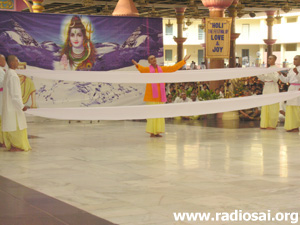 |
|
|
Mother Ganga takes Vidyapati
in Her arms
|
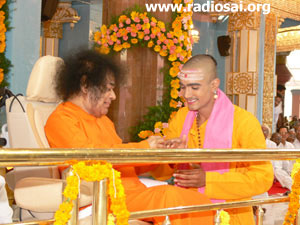 |
|
|
|
A ring for Vidyapati
|
A ring for the drama director
|
Even while the drama was going on, He could not contain Himself and called Vidyapati to Him in the midst of the scene and made a ring for him. After the end of the play, He specially called for the drama director – Mr. Mishra and made a ring for him also. He also satisfied everyone’s desire and posed for photographs with all. He then asked the participants to sing bhajans for Him and stayed for a long time listening to the bhajans sung by the actors and the bhajan troupe that had come down from Bihar.
Truly it was a tremendous way to celebrate Holi, one celebration that will remain evergreen in everyone’s memory - not only for the scintillating fare but also for the enthusiasm shown by the Lord and His childlike response to what His devotees from Bihar lovingly offered at His Lotus Feet.
MARCH 27TH: TWELFTH CLASS PRESENTATION ENTITLED 'THE INWARD PATH'
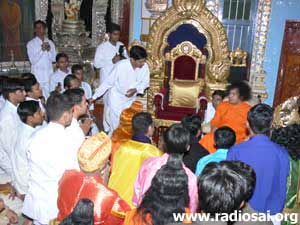 |
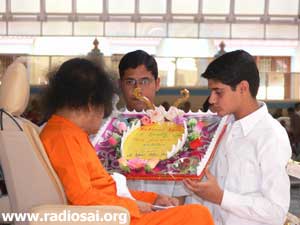 |
|
|
Swami talks with the actors in
the mandir
before the programme |
|
A card to obtain Swami's
blessings
|
On the 27th of March, the class XII students of the Higher Secondary School, put up a presentation entitled, ‘The Inward Path’. The presentation was an expression of gratitude to Bhagavan and also a recollection of some of His teachings that they had imbibed during this important phase of school life. It was interspersed with stories from Bhagavan’s Chinna Kathas and songs.
At the very beginning, two students discuss about the innumerable virtues imbibed by staying with Bhagavan. But then, they feel that all efforts would bear fruit only if they did not perform their activities mechanically. To illustrate this, a short story was enacted.
|
It is a story of two woodcutters, Gopi and Hari, who have joined a logging firm together. While Gopi works intelligently and takes care of every detail, Hari toils harder than everyone, works overtime and sacrifices his break time too. When they go to receive their wages at the end of the week, Hari is shocked to learn that while Gopi has received a bonus, he has been dismissed. On taking up this matter with his employer, he learns that his efficiency has been dropping, despite his hard work. He is unable to understand this. His employer then asks him if he has been sharpening his axe regularly. Hari then realizes where he has gone wrong! Thus ‘sharpening the axe’ has a great significance in our lives. The students then compared it to the inner transformation that must accompany outward actions and that just as ‘sharpening the axe’ was a continuous process; we too must from time to time check our inner progress in order to derive the maximum benefits. |
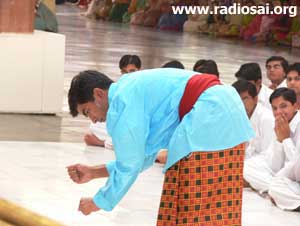 |
|
|
Sharpening the axe is a
continuous process
|
|
But then from where should one begin? One must put in efforts from one’s side - that is self effort. A well known story from Bhagavan’s Chinna Kathas was enacted to illustrate this. A farmer was once proceeding to town in his bullock cart. All of a sudden the roads become inhospitable and a wheel of his cart gets stuck in the muddy track. The farmer however, does not put any effort to remove the wheel. However, being a devotee of Lord Rama, he sits down to chant the Lord’s Name, expecting a miracle to occur. It is then he hears a voice from above reminding him that God had given him a strong body and that he is not putting in the slightest effort to pull the cart from the mud. Thus, God helps only those who help themselves. |
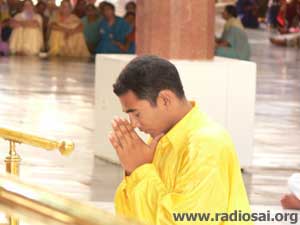 |
|
|
God helps those who help
themselves
|
At this point, a third person who has been listening to the anchors says that at times he sees people getting what they do not deserve. This makes him feel that God is partial. One of the presenters says that it is a common doubt and recollects an incident from the life of king Janaka (another ‘Chinna Katha') which was enacted.
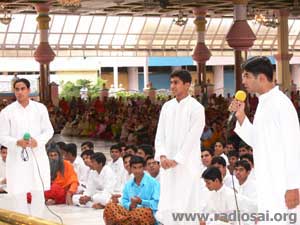 |
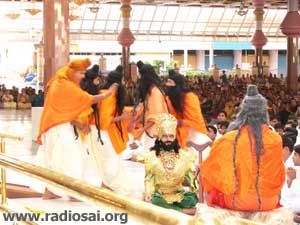 |
|
|
Is God partial?
|
|
Janaka remains unmoved by the
fire
|
King Janaka used to visit the ashram of sage Yajnavalkya often. One day the king is unusually late. The sage thus does not start the classes. King Janaka enters and apologizes for being late. The other disciples then feel that the sage waited for Janaka just because he is the king and that he never waited for anyone of them. The sage reads their thoughts by his powers and creates an illusion of fire burning the entire city of Mithila. All the other students run for their lives except Janaka, who sat unmoved in meditation. Pleased, the sage withdrew his illusionary fire. The disciples then return and find Janaka in meditation. They realize their folly. In their ignorance, little did they know that the king was far ahead of them on the inward path.
Thus what we see is only the tip of the iceberg but God sees the totality. He takes into account the past, present and future. Thus what he does is for our own good. At this point another relevant topic of discussion comes up - ‘the wavering mind’. The boys say that the mind can be controlled if thoughts are channeled in the right direction. Swami says, “Dust You Think, Dust You Are. God You Think, God You Are”- a saying well illustrated by the following Chinna Katha.
|
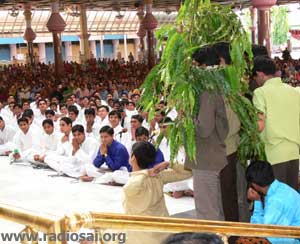 |
|
|
Let me rest under this tree
|
[Drinks]
This hunger is killing me. I wish I had some food to eat.
[Food appears]
Huh? Now…from where did this come?
Anyway I can’t wait!
[Eats]
I feel extremely sleepy. How nice it would be if I could relax a bit.
[A chair appears]
My chair?!!?? How come it is here? This is no ordinary place. Never mind. Let me have a nap.
|
|
|
|
The demon finishes Hiralal
|
The anchors then felt that the world was like a wish-fulfilling tree. As we think so we become. Swami often tells that even if we cannot control the mind, we must direct our thoughts towards Him and He would take care. They also said that this inward journey is the beginning of the four F’s namely: Follow the master, Face the devil, Fight till the end and Finish the game. It is Follow the master and then Face the devil. We would anyway have to face the devil, but it is very important to fight till the end, which was illustrated by the next story.
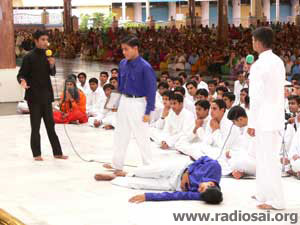 |
A boy named Ravi was going to attend the last paper of his board exam. On the way, he finds his classmate, Ramesh bleeding and seriously injured. Ramesh had ill-treated Ravi many a time. Thus Ravi is in a dilemma, the good and bad in Ravi separate out from him. The bad reminds him of all the improper things Ramesh had done to him while the good tells him about the importance of human life and that one shouldn’t have hard feelings for anyone as God guides everyone in his own way. Good says that maybe God guided Ramesh to put obstacles in his path so that Ravi becomes more determined and works even harder. Then bad brings in the point that Ravi may miss his exam if he helps Ramesh. But good reminds Ravi of his promise to be good to God. Ravi gives up the idea of taking his exam. |
|
|
The good and the bad fight for
Ravi's mind
|
He takes Ramesh to the hospital where he receives treatment and is discharged after four hours. As Ravi comes out of hospital, he meets Ajay and asks him about his performance in the exam. He surprises him by saying that the exam is postponed as there was a paper leak and that it would be held 15 days later. Ravi is filled with joy and is also happy that he and Ramesh could write the exam. He is grateful to God for showering his grace.
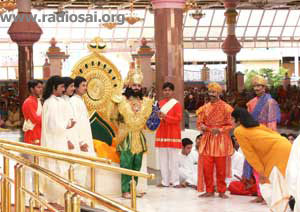 |
After the presentation, the anchors discuss about difficulties which arise whenever one chooses to tread the right path. They further add that if one surmounts these obstacles then God shall reward one in much greater ways than what one aspires for. As they discuss another point comes up that in spite of one’s effort one always remains attached to the physical, the outward which drags one away from one’s goal, the inward path. This is illustrated by yet another story. When Ashtavakra entered the assembly, the scholars and pundits started laughing at his appearance. Then he laughs at them and addresses them as shoemakers and cobblers for assessing him by his physical appearance. He says that true pundits are those who see unity in all creation and ‘charmakaras’. |
|
|
Ashtavakra in the assembly
|
|
Then the anchors relate that what begins with simple effort ultimately must lead to vision of the underlying unity of all creation. Controlling the senses and the mind, conquering the six inner enemies, these are various processes which constitute sharpening of the axe. When one fights to the end, the compassionate Lord showers His grace. Only His grace can lead one to the ultimate destination, the journey form ‘I’ to ‘we’ and finally to ‘HIM’. The anchors tell how Swami was gracious enough to point the shortcomings in them during their previous class programme and that all the boys have been putting in efforts to be worthy of His love. At the end they pray to Swami to help them to forever march forward, inward and ultimately Godward. |
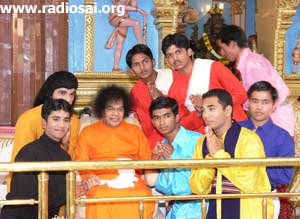 |
|
|
The group photograph
|
In the end Bhagavan was pleased with the presentation and graciously blessed the students with group photographs. He also told all the boys to be good and happy always.
MARCH 29TH: XI CLASS PROGRAMME ON CHAITANYA MAHAPRABHU
|
29th March, 2006 was indeed a memorable day for the students of the 11th Class of the Sri Sathya Sai Higher Secondary School. With Bhagavan’s blessings, the students performed a drama entitled “Sri Krishna Chaitanya”. It had a blend of good melodious music, scintillating sets and above all a sincere straight-from-the-heart effort from all the students. It was all the more creditable as they put up the play just 3 hours after they had completed their final exam. The play started with a Gurukul ashram scene with a guruji singing a song in praise of the Lord accompanied by his disciples. After that, the guruji taught his disciples the importance of the sweet name of the Lord. As the guruji was talking, a young Gauranga of Navadweep enters seeking spiritual advice; the guruji realizing his thirst for spiritual knowledge and initiated him with the Gopalaya mantra. In hindsight, perhaps the guruji was very much aware that this young Gauranga would one day stir the masses and lead them to God. |
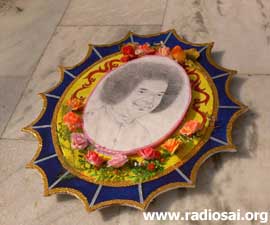 |
|
|
The card prepared for Swami
|
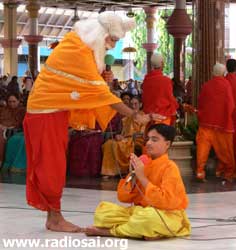 |
Many years passed and young Gauranga grew up to be the great scholar Vishvambhar and an ardent devotee of Lord Krishna. He had his disciples whom he taught Panini’s grammar. One day while he was preaching to his disciples, the topic about another great scholar named Digvijay pundit propped up. The guruji was told by his disciples that this pundit, who though blessed with immense knowledge by goddess Saraswati, was still a proud and very arrogant man. He was also told that this pundit was visiting Nawadweep. The next scene opens with Digvijay Pandit glorifying and boasting about himself and he boasts about his triumphant march across the Eastern part of the country. He is informed by his disciples about Vishwambar and his popularity. The scene ends with Digvijay Pandit promising his disciples of an assured victory when they have a clash to see who is superior. |
|
|
The Guru initiates the young
Chaitanya
|
The following scene shows the encounter when both the scholars came face to face. Digvijay Pandit boasts of his poetic experience which Vishwambar humbly accepts. When Vishwambar requests him for his sweet rendering, he acknowledges with a song. After the song, Vishwambar praises Digvijay Pandit and says that he had not seen any scholar comparable to him. Digvijay however speaks sarcastically and asks Vishwambar to render a poem on the mother as his part of the challenge, which Vishwambar accepts. While he was singing, Digvijay mocks him initially, but very soon seeing the evolved stature of Vishwambar, he realizes that he underestimated the prowess of this divine being. He accepts Vishwambar’s supremacy and falls at his feet.
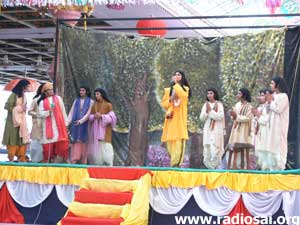 |
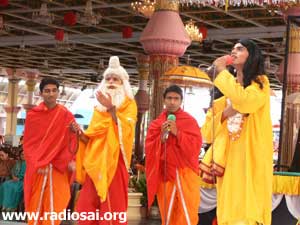 |
|
|
The confrontation with
Digvijay Pundit
|
|
The guru assures Chaitanys
that he will see God
|
In the next scene, Chaitanya (Vishwambar) searches for Krishna through a song full of longing. He enquires from people whether they know the whereabouts of Krishna and when the people tell him that they have not seen Krishna of that description, he hallucinates and falls into a trance and then visualizes Krishna dancing with the gopis. The Guruji then enters the scene and arouses Chaitanya from his trance. Chaitanya is filled with remorse for coming late into Krishna’s fold. The Guruji consoles Chaitanya and tells him that he will surely feast his eyes on the form of Krishna some day and ultimately merge with Him.
After this incident, whenever Chaitanya took classes, he would lose himself in Krishna consciousness. This affected the learning of his students. One day when the students expressed their feelings to their master, Chaitanya told them that henceforth he would teach only the glory of Krishna. If they wanted to learn Panini’s grammar, they would have to seek another teacher.
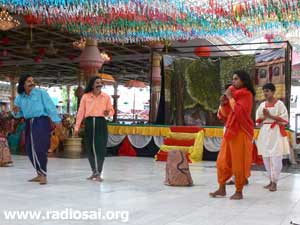 |
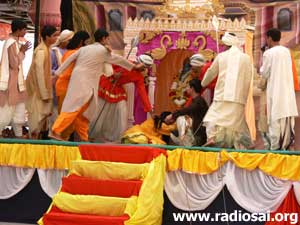 |
|
|
Jagai and Magai harass a
devotee of the Lord
|
Chaitanya faints in the temple
|
The next scene opens into a town named Navadweep, where there lived two drunkards, Jagai and Madai. They live only to taste the sensual pleasures of the world and are total atheists. A devotee of Krishna was singing the Lord’s Name and disturbed by the bhajan, Jagai and Madai hit the devotee. At that time Chaitanya Mahaprabhu comes and transforms the two drunkards and takes upon himself their sins thus granting them salvation.
The last scene is in a Krishna temple. The temple pujari and one of Chaitanya’s disciples discuss the greatness of their master. As they discuss, their master comes to the temple. When he sees the idol of Krishna, he shouts ‘Krishna Krishna’ and collapses into a trance on the steps leading to the sanctum sanctorum. The person in charge of the temple declares Chaitanya to be dead and asks that his dead body be removed from the temple. As he chides the disciple of Chaitanya, a troop of dancing bards come and sing a song that asks where the soul goes when the body collapses. When the song reaches the climax with “Govinda Gopala”, Chaitanya awakens from his trance. The temple in charge seeks his pardon and Chaitanya transforms him too.
|
While this was going on, a leper enters the temple without being noticed by anyone. Once the people around him realize this, they shout at him and try to drag him away from the temple. But, Chaitanya who was watching all this stops them and approaches the leper even against strong protests from the leper himself who requests Chaitanya not to approach him. Undeterred, he touches the leper and instantaneously the leper gets healed by his pure love and divine consciousness. Thus Sri Krishna Chaitanya stirs the hearts of the masses and leads them to God. Today Sri Krishna Chaitanya lives in the hearts of the people as a symbol of deep and intense devotion to God. His profound love for God lives on inspiring thousands and thousands of people to tread the path of love which will ultimately lead them to communion with the divine. Swami too, has always wanted us to love God through intense devotion and unflinching faith in Him. |
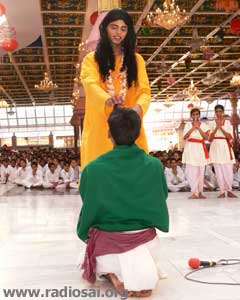 |
|
|
Blessing the leper after
healing him
|
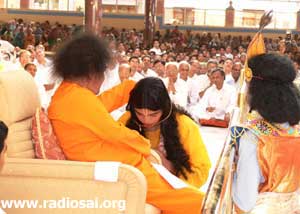 |
The wonderful drama pleased Bhagavan and everyone present very much. Swami accepted their humble request and blessed all of them with the coveted group photographs. A little prior, Swami called the student who acted as Sri Krishna Chaitanya and expressed His happiness over their brilliant acting. He also blessed him and materialized a gold chain with a Lord Ganesha pendant and He Himself put it around his neck. He also told all the students that the following day, He would provide lunch to all. |
|
|
A chain for Krishna Chaitanya
|
This was certainly one of the most memorable days for the students of Sri Sathya Sai Higher Secondary School. And what a glorious way to end the school year, by having lunch at the Lord’s residence!
MARCH 30TH: UGADI CELEBRATIONS IN SAI KULWANT HALL
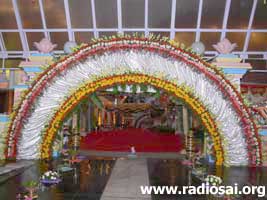 |
Ugadi marks the beginning of the New Year in the Southern States of Andhra and Karnataka. It also brings happiness with the onset of Vasanth or the Spring season. Varahamihira, a saint who lived in the sixth century, started this new method of marking the passage of a year basing his calculations with the onset of spring. The name Ugadi is derived from Yuga Aadi (Yuga + Aadi means beginning of New Age). Thus Ugadi heralds not only the beginning of the New Year but also signals the beginning of a new regeneration with plants acquiring new life, shoots and leaves; animals and birds bestir themselves and the sweet fragrance of budding flowers is in the air. |
|
|
The decorated arch at the
poornachandra entrance |
|
Preparations for the festival begin many days prior with houses being cleaned thoroughly. People go shopping and buy themselves new clothes to wear on this special day. People also splash fresh cow dung water on the ground in front of their house and draw intricate floral designs, using multi-coloured powder, called rangoli. |
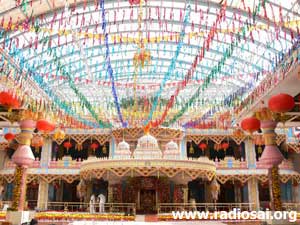 |
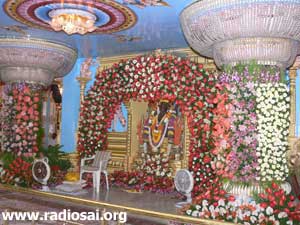 |
|
|
A view of the decorated Sai
Kulwant Hall
|
|
The facade covered with
flowers
|
And on the dawn of the New Year, people wake up early and take a traditional “oil bath” before putting on new clothes. The entrance to their houses is decorated with mango buntings as it is an omen of good luck and prosperity.
The Lord takes care of all as we are all His family. Some weeks prior, Swami had distributed clothes to all the students and staff. Everyone had the clothes stitched and all assembled in the Hall were looking resplendent and grand in their new clothes not only on the Ladies’ side but even on the gents!
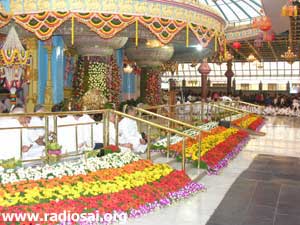 |
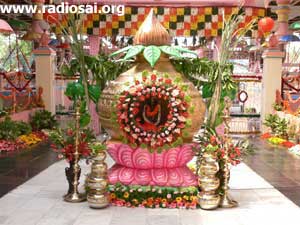 |
|
|
The flowers on the steps
|
The poorna Khumbam at the back
of the hall
|
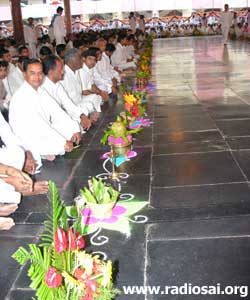 |
March 30, 2006 dawned bright and early to a richly decorated Sai Kulwant Hall. The entire façade was done up with flowers and even the steps were laid out as a flower garden. An oversized arch richly adorned the entrance on the Poornachandra auditorium side of the hall through which the Lord enters Sai Kulwant Hall. An oversized poorna khumbam (an ornate vessel used in prayer rituals) was erected at the back of the hall with an idol of Lord Ganesha inside and this lent an air of grandeur to the entire Hall. The pathway through which the Lord was to pass was also decorated with villaku (lamps) and either a coconut or a raw mango in a bed of leaves. On this auspicious day, people go to the nearest temple early in the morning or else offer pooja (prayer) to God in their own home, invoking His blessings for the New Year. The day itself is considered auspicious, so people start new ventures on this day. And this Ugadi day not only fell on a Thursday, the most auspicious day of the week, but was rendered even more so by the fact that the Lord was moving into His new residence on this day. |
|
|
Early morning view of the
decorated entrance
to the new residence |
Swami entered Sai Kulwant Hall looking radiantly beautiful in His yellow robe and even more so, with His enthusiasm reflecting the mood and feelings of the crowd assembled that day to usher in this special day with the precious darshan of the Lord and a prayer to Him to bless them in all their undertakings in the New Year.
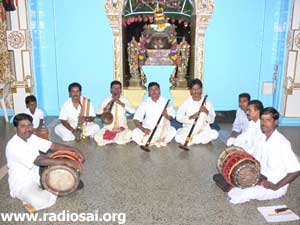 |
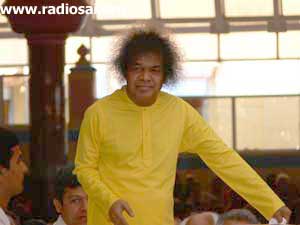 |
|
|
Nadaswaram music was played
early in the morning
|
|
The Ugadi darshan
|
After giving His New Year darshan to the assembled multitudes, Swami took His throne and then asked the Institute Marching band to play. They played a couple of renditions like La Bamba and O when the saints go marching in…
Swami then took arathi and got onto His specially modified open one-seater vehicle to give the unrestricted bliss of His darshan to all as He returned back to His residence to proceed with the rituals connected with moving in into His new house. After all, when the divine takes human form, He abides by the customary social customs and norms, and thus sets an ideal for humanity to emulate.
About 300 tables were laid out for the purpose and special food service tents were set up on either side of the central aisle way for quick service to both the Gents as well as the Ladies side.
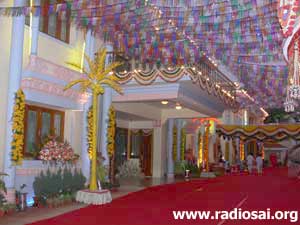 |
Professors, Heads of the departments as well as doctors and other special guests were seated inside the annex building to the new house, where on the ground floor there is a huge open hall. Swami first entered this annex and blessed everyone and supervised the serving of the food there before He proceeded to the Poornachandra auditorium. The boys had prepared a cake for Him which He cut and made all of them happy. Inside Poornachandra auditorium, He went up and down the aisle raising His hands many times to bless one and all, before He retired to His abode. |
|
| Subscribe to saibabaofindia Group for Latest Sai Baba News & latest Pictures in your mailbox |
|
|
If one truck cleared the way, It was around 5.30 in the morning.
This new year - Ugadi was special,
There were spectacular lights,
So many people,
About a furlong away, |
|
|||
|
|||||
Some rituals are intricately intertwined with Ugadi. One is the eating of a “pacchadi” or a pudding made of Bevu (neem) and Bella (jaggery). The neem, though it tastes bitter in taste is good for health. It is also used in cosmetics, toothpaste, soaps, cow fodder, manure, oil and others products due to its high medicinal content. It is also useful for patients having diabetes and skin diseases. Jaggery increases the hemoglobin in the blood and provides additional energy for the body. But the inner significance of eating this bitter-sweet mixture is to indicate that life itself is a mixture of good and bad, joy and sorrow, success and disappointment, and all of them have to be treated alike. All experiences have to be treated with equanimity. Everyone should resolve to face calmly whatever happens in this New Year, accepting it with good grace.
|
The celebration of Ugadi is thus marked not only by religious zeal but also with social merriment as people make use of the holiday to visit friends and relatives. Special “must make” dishes for this occasion in Andhra Pradesh are eatables such as "pulihora", "bobbatlu" and preparations made with raw mango. In Karnataka too, similar preparations are made but are called "puliogure" and "holige". In keeping with this tradition, the luncheon menu included not only the Ugadi pacchadi and pulihora but also a variety of sweets that are popular with the Andhras. Rice forms the staple diet in South India and the menu also included vegetables prepared in the traditional style. Everyone partook of this prasadam from the Lord with reverence and awe for their unexpected good fortune of ushering in the New Year in this most auspicious fashion.
|
 |
|
In the evening, after Swami came into Sai Kulwant Hall, He blessed the boys of the Institute to put up their small skit which they had specially prepared to explain to everyone the tradition and rituals connected with the Ugadi festival. They thus explained that this day was celebrated as the day on which Brahma created the cosmos. It is thus special not only to the people of Andhra Pradesh, Karnataka and Maharashtra but also to the Sindhis.
They explained the significance of the Ugadi pacchadi and also brought out the inner significance of another intricate ritual called the Panchanga Shravanam.
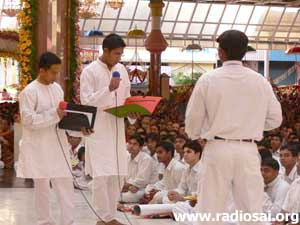 |
People listen to Panchanga (or Panchanga Shravana - the traditional recital of the almanac highlighting the important effects and assurances of the New Year) on Ugadi. The economy of the Southern states are mostly agrarian and hence these panchanga meetings are usually held in the village square and experts forecast rain, crop, storms, crop prices and other relevant things of interest to the rural farmer in the year to come; but with the onset of modern technology, one can get to hear the priest-scholar on cable television sitting in comfort in one's own living room! The boys in their skit explained that pancha anga (the 5 limbs) actually refers to the five senses and shravanam is the first step on the nine fold path of bhakthi towards the Lord. Hence they said that after controlling the senses, one must take the first step towards the Lord to achieve the purpose of life. |
|
|
Panchanga Shravanam in the
boys' skit
|
The boys then did an authentic reading of the almanac, in keeping with the Ugadi tradition, to the wonderment of the whole crowd. They said that Guru (the planet Jupiter) is the king of this year. Guru is the Lord of rains and commerce. Hence a general prosperity in all these areas can be expected. However, Shukra (the planet Venus) as the minister of the year can exhibit adverse effects on the Indian political scene. The programme also highlighted the proportion of expenses to income and the proportion of insults to praises that various zodiac signs can expect this year. Thus people belonging to the Vrishaba (Taurus) Zodiac can expect Rs. 14 in expenses for Rs. 5 in income and also in this New Year they would be praised 5 times for every 4 insults they had to bear. In conclusion, they reminded everyone that no planet, however powerful, can ever exert its influence on all those who seek refuge in the love of Sai; for His love is the mightiest and most benevolent of all.
|
In the last act the boys used an example of a man who had troubles with the boss at work to show that the world is tinted depending on the colour of the glasses that you wear. Thus they said that we should always see good and do good for that is the way to God. At the conclusion of this well written, topical and thoroughly enjoyable skit, Swami signaled that His table be brought for He wanted to give His Divine discourse to the immense pleasure of the crowd. In His discourse, Swami talked about the Pandavas and the lessons to be learnt from their lives. Bhagavan related how Arjuna shot a fish with his arrow and so fulfilled the test put forward by the King to win the hand of Draupadi. Then He said,
|
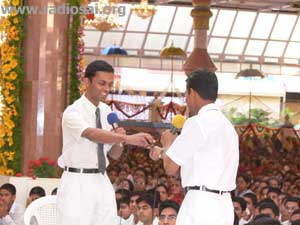 |
|
|
The world looks tinted with
tinted glasses
|
Children should follow strictly the command of the Mother. They went inside, prostrated at her feet and promised to follow her wish. Thus since that time Draupadi was known as Panchali – the wife of five people.
But how can worldly minds accept this? It is the duty of children to follow their mother irrespective of others’ opinions. Thus people understood the significance and reconciled themselves to this course".
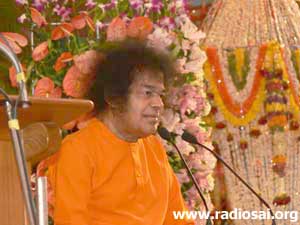 |
Swami also talked about anger, a disease that all of us suffer from. He said that
Along the same lines, the Lord also lovingly gave guidelines for a Dharmic life. He said,
|
|
Has God given good and bad? No, He has not given these. Each one conducts himself in his life and God is the Witness. He does not give grief and pleasure - these are the results of our actions. If we speak sweetly we will have a sweet reply. If we speak harshly so will be the reply. As is the action so is the reaction. Reaction, reflection and resound are the result of our own actions, like a mirror. Whatever we speak comes back to us. Reflection means that our inner thoughts will express themselves outwardly. Therefore it is necessary to find out the good and bad in all actions. If one finds an action is bad it should be given up immediately. If we are determined to follow this we will be successful in life. Good and bad are based on inner feelings and they are mixed. It is not possible to separate them. The moment good comes the bad disappears. Therefore you do not have to remove the bad separately.
|
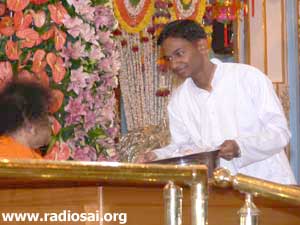 |
|
|
Blessing the prasadam
|
Thus ended a historic memorable month in Prashanti Nilayam. We hope you have enjoyed reading this rather long account of the chronicles of this month's events. And as summer is upon us, and schools close and everyone heads for a vacation, do take time everyday to think of God.
So till next time, we wish you the very best.
- Heart2Heart Team
Source: radio sai